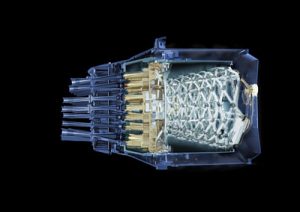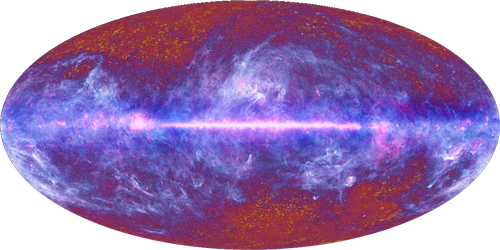
After an impressive two and a half years of operation, Planck’s High Frequency Instrument has finally exhausted its onboard coolant gases and reached the end of its very successful mission. Meanwhile the Low Frequency Instrument, which does not need to be super-cold, will continue taking data with unprecedented sensitivity at longer wavelengths.
Planck’s primary mission is to observe the Cosmic Microwave Background – the afterglow of the Big Bang. Despite an original mission lifetime of a year, the spacecraft has continued working for almost three years, and has mapped the sky nearly five times. The expansion of the Universe means that the Cosmic Microwave Background is brightest when seen in microwave light, with wavelengths between 100 and 10,000 times longer than visible light. To measure such long wavelengths Planck’s detectors have to be cooled to very low temperatures, with the heart of the High Frequency Instrument (HFI) being the coldest place in space.
Professor George Efstathiou, at University of Cambridge and the Planck Survey Scientist, said “Planck is giving us the best ever view of the early Universe, and while the High Frequency Instrument is coming to the end of its mission we have a wealth of data to analyse over the coming months and years.” Although Planck is an international project, led by the European Space Agency, there is strong involvement from scientists in the UK. Scientists at University of Cambridge, Imperial College, University of Manchester and Cardiff University have been involved in the design, construction and operation of Planck and its instruments for over a decade, and are now heavily involved in analysis of the data. In addition, one of three refrigeration systems was designed and built at the Science and Technology Facilities Council’s Rutherford Appleton Laboratory near Harwell, Oxfordshire.

The detectors of the High Frequency Instrument (HFI) only work properly when cooled to very low temperatures, and for the duration of the mission have been cooled to 0.1 degrees above absolute zero (-273.15 Celsius) – making them the coldest known place in space! The refrigerator that keeps them cold relies on helium gas, and it is this that has finally been exhausted.
Cardiff University researchers, led by Professor Peter Ade, have been heavily involved in the design, build, testing and operation of HFI for over ten years. “We put as much Helium-4 and Helium-3 gas onboard as we could squeeze in and are therefore delighted that the HFI has operated for almost three times its nominal mission lifetime”, explained Professor Ade. “This is a testimony to the expertise of the scientific and technical teams who designed, built and operated Planck and its scientific instruments.” With the loss of cooling gases the detectors will gradually warm rendering them unusable for scientific purposes. Following a salvo of final tests the HFI instrument will be switched off, although it will remain at a chilly -269 Celsius providing a reference source for the LFI which will continue to operating for at least another year.
Planck’s second instrument, the Low Frequency Instrument (LFI), does not need to be as cold, though is still at a nippy -255 Celsius. Astronomers from Jodrell Band Centre for Astrophysics, at the University of Manchester, have played a key role in LFI. “The Low Frequency Instrument will now continue operating for another year”, said Richard Davis, of the University of Manchester. “During that time it will provide unprecedented sensitivity at the lower frequencies.” It is the combination of both instruments that makes Planck so powerful, and gives cosmologists the best ever view of the Universe on the largest scales.
The scientists involved in Planck have been busy understanding and analysing the data since Planck launched in May 2009, with UK efforts being led by the Cambridge Planck Analysis Centre, based at the University of Cambridge. “The fact that Planck has worked so perfectly means that we have an incredible amount of data,” explained Prof Efstathiou. “Analysing it takes very high-performance computers, sophisticated software, and several years of careful study to ensure that the results are correct. In fact, the preparation for this work started years before Planck was even launched”. Detailed information about the early Universe is now being extracted from the Planck data, with the first cosmology results expected in early 2013.
Professor Andrew Jaffe, from Imperial College London, is also involved in the analysis through the London Planck Analysis Centre, and said “In the last two and a half years, Planck has collected incredible data directly from the early Universe which we currently decoding. We are honoured to have the chance to continue to work with members of the Planck team, in the UK and abroad, and to use Planck’s data to understand the Universe on the very largest scales.”
One of the major tasks is identifying which bits of the map are showing light from the early Universe, and which parts are due to much closer objects, such as gas and dust in our galaxy, or light from other galaxies. While the cosmologists consider these “foreground” objects to be an annoyance that need to be removed, for some astronomers they are already providing major astronomical results.
“A side effect of studying the distant Universe is that you get to see everything in the foreground,” said Dr Clive Dickinson, from the University of Manchester. “The wavelengths Planck observes make it ideal for studying star formation, both in our own galaxy and in others, and having such detailed maps of the entire sky at such a wide range of wavelengths is provides a treasure trove of information.” Astronomers have been pouring over the data and have already confirmed the existence of two additional components of the interstellar medium – the gas and dust from which stars form. There are more results on these foregrounds expected to be released during 2012.
“It has been a privilege to be part of the Planck team”, concluded Prof Efstathiou. “The satellite has performed flawlessly since launch and has returned data of exceptional quality. I am sure that we will soon have exciting science results on the early Universe.”
We’re very pleased with how Planck has performed, well beyond expectations,” said Professor Alvaro Giménez, The European Space Agency’s Director of Science and Robotic Exploration. “This is a great credit to the work done by the many scientists and engineers involved across Europe and elsewhere in the world. In reality though, we’re only halfway through the mission: there’s a lot still to be done to analyse the data and come up with the exciting scientific results that everyone’s anxiously expecting.”
